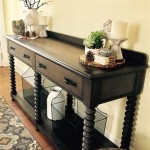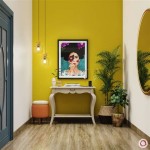How To Craft Personalized Home Decor: A Comprehensive Guide
Creating personalized home decor offers a cost-effective and expressive way to reflect individuality and style. Rather than relying solely on mass-produced items, handcrafting decor allows for unique designs, custom color palettes, and materials selections that align with specific preferences and the existing aesthetic of a living space. This process can also prove to be a therapeutic and rewarding experience, fostering creativity and providing a sense of accomplishment.
The journey of creating bespoke home decor begins with a thoughtful consideration of the existing space. Evaluate elements such as wall colors, furniture styles, and overall ambiance. This assessment forms the basis for informed decisions regarding the style, color, and scale of the decor pieces that will be crafted. A clear understanding of the current environment prevents the creation of pieces that clash with the established aesthetic or appear out of place.
Following the initial assessment, identifying the desired type of decor is crucial. This could range from wall art and textiles to decorative objects and repurposed furniture. The choice should be guided by personal interests, skill level, and the availability of materials. Starting with simpler projects can help build confidence and refine techniques before tackling more complex designs.
Selecting and Preparing Materials: A Foundation for Success
The selection of appropriate materials serves as the cornerstone of successful home decor creation. Consider the desired aesthetic, the intended lifespan of the piece, and the ease of working with various materials. Wood, fabric, paint, clay, metal, and repurposed items each offer unique characteristics and possibilities.
Wood, for instance, lends itself to a range of projects, from rustic signs and picture frames to intricate sculptures and furniture accents. The type of wood selected will impact the final appearance and durability of the piece. Softwoods, such as pine, are relatively easy to work with but may be more prone to dents and scratches. Hardwoods, such as oak and maple, offer greater durability and a refined aesthetic but require more specialized tools and techniques.
Fabric opens up avenues for creating textiles, such as throw pillows, curtains, and wall hangings. Cotton, linen, velvet, and silk each possess distinct textures, weights, and drape qualities. The choice of fabric should align with the intended use of the textile and the overall style of the room. For example, durable cotton may be suitable for throw pillows in a high-traffic area, while delicate silk may be preferred for decorative wall hangings in a formal setting.
Paint provides a versatile medium for transforming existing objects or creating new works of art. Acrylic paints are water-based and dry quickly, making them a popular choice for beginners. Oil paints offer richer colors and a longer drying time, allowing for greater blending and manipulation. Specialized paints, such as chalk paint and metallic paint, can add unique textures and finishes to decor pieces.
Clay offers the opportunity to create sculptural elements, decorative bowls, and personalized ornaments. Air-dry clay is a convenient option for beginners, requiring no firing. Polymer clay can be baked in a conventional oven, offering greater durability and a wider range of colors. Kiln-fired clay requires specialized equipment but results in the most durable and permanent ceramic pieces.
Repurposing existing items is an environmentally conscious and cost-effective approach to home decor. Old furniture, discarded wood pallets, and vintage textiles can be transformed into unique and functional pieces. Repurposing requires creativity and ingenuity, as well as basic woodworking or sewing skills.
Regardless of the materials selected, proper preparation is essential. Wood should be sanded smooth and primed before painting or staining. Fabric should be washed and ironed to prevent shrinkage and wrinkles. Surfaces should be cleaned and degreased to ensure proper adhesion of paints and adhesives.
Mastering Essential Techniques: From Basics to Refinement
Acquiring fundamental techniques is crucial for translating design ideas into tangible home decor pieces. These techniques vary depending on the chosen materials and the complexity of the project. However, certain skills, such as measuring, cutting, assembling, and finishing, are universally applicable.
Accurate measuring and cutting form the foundation for creating precise and well-proportioned decor pieces. Use a measuring tape, ruler, and square to ensure accurate dimensions. Employ appropriate cutting tools, such as saws, scissors, and rotary cutters, to achieve clean and precise cuts. Safety precautions, such as wearing safety glasses and gloves, are paramount when using cutting tools.
Assembly techniques vary depending on the materials used. Wood can be joined using nails, screws, glue, or dowels. Fabric can be sewn together using a sewing machine or by hand. Adhesives, such as glue and epoxy, can be used to bond various materials together. Understanding the strengths and limitations of each assembly technique is essential for creating durable and structurally sound decor pieces.
Finishing techniques enhance the appearance and durability of decor pieces. Painting, staining, varnishing, and sealing protect surfaces from moisture, scratches, and UV damage. Sanding, polishing, and waxing create a smooth and refined finish. The choice of finishing technique depends on the desired aesthetic and the intended use of the piece.
Beyond these basic techniques, specialized skills may be required for more complex projects. Woodworking techniques, such as joinery and carving, enable the creation of intricate furniture and sculptural elements. Sewing techniques, such as quilting and embroidery, allow for the creation of elaborate textiles and decorative embellishments. Ceramic techniques, such as wheel throwing and hand building, enable the creation of unique pottery and sculptural forms.
Continuous learning and practice are essential for refining techniques and expanding creative possibilities. Online tutorials, workshops, and books offer valuable resources for acquiring new skills. Experimentation and exploration are encouraged to discover personal preferences and develop a unique artistic style.
Design Considerations: Style, Color, and Composition
Design principles play a vital role in creating visually appealing and harmonious home decor pieces. Considerations such as style, color, and composition influence the overall impact of the decor and its integration into the existing environment.
The style of the decor should complement the overall aesthetic of the living space. Consider existing furniture styles, architectural details, and personal preferences. Common decor styles include modern, minimalist, bohemian, farmhouse, and traditional. A cohesive style creates a sense of harmony and visual balance.
Color plays a significant role in shaping the mood and atmosphere of a room. Consider the psychological effects of different colors and their compatibility with the existing color palette. Warm colors, such as red and orange, create a sense of energy and excitement. Cool colors, such as blue and green, create a sense of calm and relaxation. Neutral colors, such as white, gray, and beige, provide a versatile backdrop for bolder accents.
Composition refers to the arrangement of elements within a decor piece. Consider principles such as balance, symmetry, contrast, and proportion to create visually appealing arrangements. Balance can be achieved through symmetrical or asymmetrical compositions. Symmetry creates a sense of order and formality, while asymmetry creates a sense of movement and visual interest. Contrast can be achieved through variations in color, texture, and shape. Proportion refers to the relative size and scale of elements within the composition.
In addition to these fundamental principles, consider the functionality of the decor piece. Design should not only be aesthetically pleasing but also practical and functional. For example, a decorative storage box should be both visually appealing and provide ample storage space. A wall hanging should be appropriately sized and positioned to complement the surrounding space.
The process of creating personalized home decor is an iterative one. Experimentation, adaptation, and refinement are essential for achieving desired results. Embracing mistakes and learning from them is an integral part of the creative process. Ultimately, the goal is to create decor pieces that reflect individuality, enhance the aesthetic of the living space, and bring joy to the creator and those who inhabit the space.

How To Make Your Own Decorations

Craft Your Own Paper Decorations Seasalt Stories

Make Your Own Decorations Eight Easy And Classy Looking Projects To This A Bright The Guardian

Make Your Own Diy Art Decor 100 Directions

Decorating With Letters And Words 37 Striking Tutorials Show You How To Make Your Own Diy Letter Decoration Ideas A Crafts

How To Make Your Own Decorations Ian Mankin

How To Make Your Own Decorations Park Savings

10 Simple Diy Ideas To Make Your Own Home Decor And Garden

50 Fun And Easy Diy Room Decor Ideas That Won T Break The Bank
Do It Yourself Homemade Home Decoration Tips You Like Decorating Your Apartment As Much I If So Ve Come To The Right Place Especially Prefer Make







